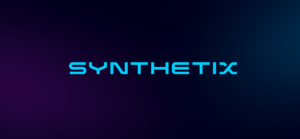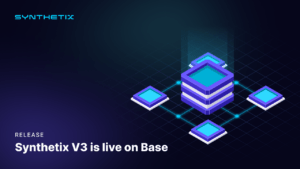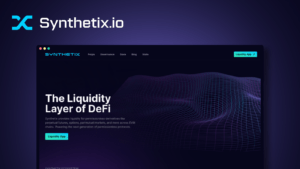Latest News
- Stablecoin Sinks to $0.68: sUSD Loses Its Peg, Sparks Fears of SNX Death Spiral?
- Synthetix Founder Reflects on Ethereum Sale Decisions
- TD Synnex Reports Q1 FY’25 Falling Short of Expectations
- US Stocks Likely To Open Mixed: 'Expect Volatility. Buckle Up,' Says Expert
Current Price
The current price of SNX is $0.63410
Introduction
Synthetix (SNX) presents a compelling case within the decentralized finance landscape, offering users the ability to trade synthetic assets that mirror real-world commodities and financial instruments.
While the underlying mechanics of its collateralization model and decentralized exchange framework suggest a robust platform, the potential for market volatility and regulatory hurdles cannot be ignored.
As we explore the intricacies of Synthetix, including its governance model and future roadmap, a clearer picture of its prospects and challenges emerges—one that merits closer examination.
Let’s go!
Quick Overview
Synthetix is a decentralized finance protocol on Ethereum, enabling the creation and trading of synthetic assets that mirror real-world assets.
- Users must lock SNX tokens as collateral to mint synthetic assets, ensuring stability through an over-collateralization model.
- The platform allows trading of diverse assets, including fiat currencies, commodities, cryptocurrencies, and stocks, without direct ownership.
- Risks include market volatility, regulatory compliance challenges, and smart contract vulnerabilities, which can impact trading outcomes.
- Governance operates as a decentralized autonomous organization (DAO), allowing SNX token holders to engage in decision-making processes for the platform’s evolution.

Overview of Synthetix
Synthetix is a decentralized finance (DeFi) protocol that enables the creation and trading of synthetic assets on the Ethereum blockchain. These synthetic assets, known as “synths,” are financial instruments that mimic the value of real-world assets, such as currencies, commodities, and stocks. By leveraging blockchain technology, Synthetix allows users to gain exposure to these assets without needing to own them directly, thereby increasing accessibility to a broader range of financial instruments.
The Synthetix platform employs a unique collateralization model where users must lock up SNX tokens as collateral to mint synths. This mechanism guarantees that the value of synthetic assets remains pegged to their underlying assets, while also providing security to the network.
Synthetix’s decentralized oracle network aggregates price feeds from various sources, guaranteeing that the data used for trading is accurate and timely.
Furthermore, the protocol facilitates an open and permissionless trading environment, empowering users to engage in speculative trading without intermediaries. This structure not only enhances market efficiency but also aligns with the core principles of DeFi, promoting transparency and democratization of financial services.
How Synthetix Works
Synthetix operates by allowing users to create synthetic assets, which are blockchain-based representations of real-world assets, using its unique collateralization model.
This process is facilitated through a decentralized exchange mechanism that enables trading of these assets without relying on traditional intermediaries.
Understanding these core functionalities is essential to grasp the overall framework and operational dynamics of the Synthetix platform.
Synthetic Asset Creation
At the core of Synthetix’s functionality lies the innovative process of synthetic asset creation, which allows users to gain exposure to various assets without directly owning them. This process is facilitated through a decentralized protocol that enables the issuance of synthetic assets, or “Synths,” which are pegged to the value of real-world assets such as currencies, commodities, and stocks.
Synthetic assets are backed by collateral provided by users who stake SNX tokens, the native cryptocurrency of the Synthetix network. This collateralization guarantees the stability and value of the Synths, as the value of the issued assets is maintained through over-collateralization. Users can create new Synths by locking up a predetermined amount of SNX, thereby enabling the seamless introduction of diverse asset classes into the Synthetix ecosystem.
The underlying framework of Synthetix also incorporates mechanisms to manage risks associated with price fluctuations, guaranteeing that the system remains robust and efficient.
In addition, the decentralized nature of synthetic asset creation eliminates the need for intermediaries, enhancing both accessibility and transparency in the trading of diverse asset classes.
Decentralized Exchange Mechanism
Operating within a decentralized framework, the exchange mechanism of Synthetix enables users to trade synthetic assets directly on the platform without the need for traditional order books or centralized intermediaries.
This innovative approach leverages a unique liquidity provision model where users, known as “liquidity providers,” stake SNX tokens to create synthetic assets, thereby ensuring that the platform remains liquid.
The Synthetix exchange operates on a model known as a “decentralized price oracle,” which integrates real-time data from various sources to determine the value of synthetic assets accurately.
This mechanism mitigates the risks associated with price manipulation, a common issue in centralized exchanges. Users can trade various synthetic assets, including cryptocurrencies, fiat currencies, and commodities, with the assurance that the prices reflect real market conditions.
Furthermore, the protocol employs a system of collateralization, where stakers of SNX must maintain a minimum collateral ratio to safeguard the stability of the synthetic assets.
This decentralized mechanism not only enhances security but also allows for greater transparency and efficiency in trading, setting Synthetix apart from conventional trading platforms.
As a result, Synthetix contributes considerably to the evolution of decentralized finance (DeFi).
Key Features of Synthetix
Synthetix offers a robust framework for creating decentralized synthetic assets, enabling users to gain exposure to a wide range of assets without owning them directly.
A key component of this system is the Collateralized Debt Position (CDP), which allows users to lock up collateral in exchange for synthetic assets.
This mechanism not only enhances liquidity within the platform but also underpins its decentralized nature, ensuring a more resilient financial ecosystem.
Decentralized Synthetic Assets
Decentralized synthetic assets represent a significant innovation within the blockchain ecosystem, allowing users to gain exposure to a wide array of financial instruments without the need for traditional intermediaries.
Synthetix, a prominent player in this space, enables users to create and trade synthetic assets, known as Synths, which are pegged to real-world assets such as currencies, commodities, and indices. This system not only democratizes access to financial markets but also enhances liquidity and price discovery through decentralized governance.
Key features of decentralized synthetic assets include:
- Global Accessibility: Users can trade Synths from anywhere in the world, eliminating geographical barriers inherent in traditional finance.
- Transparency and Security: Built on the Ethereum blockchain, Synthetix guarantees transparency and security through smart contracts, reducing the risk of fraud and manipulation.
- Diverse Asset Classes: Synthetix facilitates exposure to various asset classes, enabling users to hedge against market volatility or speculate on price movements without owning the underlying assets.
These features collectively position Synthetix as a pivotal platform for the evolution of decentralized finance (DeFi).
Collateralized Debt Position
A Collateralized Debt Position (CDP) serves as a fundamental mechanism within the Synthetix ecosystem, enabling users to mint synthetic assets by locking up collateral in the form of the native SNX token. This process involves users depositing a specified amount of SNX into the protocol, which then generates synthetic assets proportional to the value of the collateral.
The ratio of collateral to debt is essential, as it must meet the minimum collateralization ratio to avoid liquidation.
The CDP system allows for the creation of various synthetic assets, ranging from fiat currencies to commodities and cryptocurrencies, thereby facilitating a diverse trading environment.
In addition, the model incentivizes SNX holders to stake their tokens, earning rewards from trading fees generated by the platform.
However, it also introduces inherent risks; if the value of the SNX collateral falls noticeably, users may face liquidation of their positions to maintain the system’s integrity and solvency.

Benefits of Using Synthetix
One of the primary advantages of utilizing Synthetix is its ability to provide users with exposure to a wide array of assets without the need for traditional market intermediaries. This decentralized approach allows for greater accessibility and transparency, enabling users to trade synthetic assets seamlessly on the Ethereum blockchain.
Furthermore, Synthetix offers several compelling benefits:
- Diverse Asset Exposure: Users can gain access to a variety of synthetic assets, including cryptocurrencies, commodities, and fiat currencies, all in one platform.
- Permissionless Trading: With no central authority overseeing transactions, users can trade assets freely, fostering an inclusive trading environment.
- High Liquidity: The protocol’s design encourages liquidity through incentivized staking, allowing traders to execute orders with minimal slippage.
In addition to these advantages, Synthetix’s innovative use of collateralized debt positions (CDPs) enhances the trading experience by allowing users to create and manage their synthetic assets efficiently.
Types of Synthetic Assets
Synthetic assets on the Synthetix platform encompass a diverse range of financial instruments, allowing traders to gain exposure to various asset classes without the complexities typically associated with traditional markets.
These synthetic assets, referred to as “synths,” are fundamentally blockchain-based representations of real-world assets. They provide users the ability to trade on price movements without needing to own the underlying asset.
The primary categories of synthetic assets include fiat currencies, commodities, cryptocurrencies, and stocks.
Fiat synths, for instance, allow users to trade assets like the US dollar or euro, facilitating exposure to traditional currencies in a decentralized manner.
Commodity synths enable trading on valuable resources such as gold and oil, which can serve as hedges against inflation or market volatility.
Moreover, synthetic cryptocurrencies provide users access to digital assets without the necessity of directly purchasing them, thereby enhancing liquidity and market participation.
Finally, synthetic stocks give traders the opportunity to capitalize on equity movements without needing to navigate the challenges of stock exchanges.
Trading on the Synthetix Platform
Trading on the Synthetix platform offers users a unique experience characterized by its decentralized nature and the ability to engage with a diverse array of synthetic assets. This platform operates on the Ethereum blockchain, allowing users to trade assets such as cryptocurrencies, fiat currencies, commodities, and indices.
The decentralized model guarantees that trading occurs without a centralized intermediary, providing greater autonomy and control over transactions.
One key feature of trading on Synthetix is its utilization of smart contracts, which facilitate automated and transparent transactions. Additionally, users can create and trade synthetic assets by providing collateral in the form of SNX tokens, thereby enhancing liquidity and market depth.
This innovative approach empowers users to replicate real-world asset movements while maintaining the benefits of blockchain technology.
- Diverse Asset Classes: Access to a wide range of synthetic assets, including cryptocurrencies and commodities.
- Decentralized Trading: Engage in trading without intermediaries, guaranteeing autonomy and security.
- Smart Contract Automation: Benefit from transparent and efficient trading through automated smart contracts.

Risks and Challenges
The Synthetix platform faces several inherent risks and challenges that could impact its performance and user trust.
Market volatility can greatly influence the value of synthetic assets, while ongoing regulatory compliance issues may pose legal hurdles for the platform’s operations.
Additionally, smart contract vulnerabilities remain a critical concern, as any exploitation could undermine the security and integrity of the entire system.
Market Volatility Impact
Market volatility presents significant risks and challenges for Synthetix (SNX) and its users, impacting both liquidity and price stability within the decentralized finance ecosystem. The inherent fluctuations in cryptocurrency prices can lead to sudden shifts in the value of synthetic assets, which are vital to Synthetix’s functionality. This volatility can discourage potential users from engaging with the platform, as unpredictable price movements can result in significant financial losses.
Moreover, the liquidity of synthetic assets is directly tied to market conditions. During periods of high volatility, liquidity can dry up, making it difficult for users to execute trades at favorable prices. This can result in slippage, further exacerbating the losses incurred by traders.
Key considerations for users include:
- Risk of Liquidation: High volatility can trigger margin calls, leading to forced liquidations for users who are leveraged.
- Price Oracles Dependence: Synthetix relies on price feeds, which can be affected by market volatility, potentially leading to inaccurate asset valuations.
- User Sentiment Fluctuation: Increased volatility can lead to negative sentiment, deterring new users from entering the market.
Understanding these challenges is essential for maneuvering the Synthetix ecosystem effectively.
Regulatory Compliance Issues
Steering through the complex landscape of regulatory compliance poses essential risks and challenges for Synthetix (SNX) and its users. As a decentralized finance (DeFi) platform, Synthetix operates in an environment where regulatory frameworks are still evolving. This uncertainty can lead to potential legal ramifications for both the platform and its users, particularly concerning the classification of synthetic assets and the obligations that may arise under securities laws.
Regulatory bodies worldwide are increasingly scrutinizing cryptocurrency platforms, which raises the risk of compliance breaches. For Synthetix, failure to adhere to evolving regulations could result in penalties, operational disruptions, or even forced cessation of services. Additionally, the decentralized nature of the platform complicates enforcement, as liability may be diffuse among various participants.
Moreover, regulatory compliance issues can notably impact user trust and adoption rates. Users may be hesitant to engage with a platform that operates in a gray area of legality, particularly when it comes to asset ownership and tax obligations.
As Synthetix navigates these challenges, staying ahead of regulatory developments and proactively adapting to new legal standards will be essential for its long-term sustainability and growth.
Smart Contract Vulnerabilities
Maneuvering the complexities of regulatory compliance is only one aspect of the multifaceted challenges faced by Synthetix (SNX).
Another significant concern revolves around smart contract vulnerabilities, which pose inherent risks to the platform’s integrity and user assets. As a decentralized finance (DeFi) protocol, Synthetix relies heavily on the functionality of its smart contracts, making them a prime target for exploitation.
Key vulnerabilities that can arise include:
- Reentrancy Attacks: These occur when a malicious actor repeatedly calls a contract before the initial execution is complete, potentially draining funds.
- Oracle Manipulation: Synthetix utilizes price oracles to determine asset values; if these oracles are compromised, it can lead to incorrect pricing and significant financial loss.
- Code Flaws: Bugs or overlooked issues in the smart contract code can create exploitable weaknesses, undermining the protocol’s security.
The dynamic nature of the DeFi space necessitates continuous scrutiny and updates to smart contracts.
As a result, robust security audits and community vigilance are essential to mitigate these vulnerabilities and guarantee trust in the Synthetix ecosystem.
Synthetix Governance Model
As Synthetix continues to evolve within the decentralized finance (DeFi) landscape, its governance model plays an essential role in shaping the platform’s future direction and community engagement.
The Synthetix governance structure is built around a decentralized autonomous organization (DAO), which empowers SNX token holders to participate actively in decision-making processes. This model encourages a collaborative effort to address platform upgrades, protocol changes, and economic incentives.
Token holders can propose and vote on various initiatives, aligning the interests of the community with the overall health of the ecosystem. The governance framework also incorporates a tiered voting system, where larger stakeholders possess greater influence, ensuring that active participants can guide the platform’s trajectory effectively.
Additionally, transparency is a cornerstone of the Synthetix model, with all proposals and voting results publicly available for scrutiny.
This decentralized governance approach fosters a sense of ownership among participants and helps mitigate risks associated with centralized control. However, challenges such as voter apathy and the potential for governance centralization remain critical considerations.
Ultimately, the Synthetix governance model exemplifies the principles of decentralization and community involvement, which are essential for the success of any DeFi protocol.
Future Developments and Roadmap
The future developments and roadmap of Synthetix are imperative for understanding how the platform intends to adapt and thrive in an increasingly competitive DeFi environment.
As the platform evolves, several key initiatives are set to enhance its functionality and user experience, reinforcing its position in the decentralized finance landscape.
- Layer 2 Scaling Solutions: Synthetix is actively pursuing Layer 2 solutions to improve transaction speeds and reduce gas fees, making the platform more accessible to a broader audience.
- Expansion of Asset Offerings: The roadmap includes the introduction of new synthetic assets, which will diversify trading opportunities and attract more users to the platform.
This expansion is essential for maintaining liquidity and user engagement.
- Enhanced Governance Mechanisms: Synthetix is focusing on improving its governance model to guarantee more robust community participation and decision-making processes.
This enhancement aims to foster a more democratic environment, encouraging broader stakeholder involvement.
These developments are critical for Synthetix’s long-term success and sustainability, positioning the platform for growth and adaptation in a rapidly changing DeFi landscape.
Final Thoughts on Synthetix
In the ever-evolving landscape of decentralized finance, Synthetix stands out as a pioneering platform that has continually adapted to changing market dynamics. Its innovative approach to synthetic assets allows users to gain exposure to various assets without the need for direct ownership. This flexibility presents a significant advantage in a market characterized by volatility and rapid shifts in asset value.
However, Synthetix is not without its challenges. The reliance on collateralization introduces risks, particularly during periods of high market turbulence. Users must navigate complexities associated with liquidity, slippage, and the potential for liquidation.
Additionally, the platform’s governance model, while decentralized, may face hurdles in achieving consensus among stakeholders, impacting decision-making efficiency.
Looking ahead, Synthetix’s commitment to continuous improvement is evident through its roadmap, which focuses on enhancing user experience and expanding the range of synthetic assets.
Frequently Asked Questions
What Is the Origin and History of Synthetix?
The origin of Synthetix traces back to 2017, initially launched as Havven. It evolved into a decentralized synthetic asset platform, enabling users to create and trade various digital assets, greatly impacting the decentralized finance landscape.
How Can I Stake My SNX Tokens?
To stake SNX tokens, users must first acquire them via a cryptocurrency exchange. Subsequently, they can delegate their tokens to a staking contract within the Synthetix platform, earning rewards while contributing to network security and liquidity.
Are There Any Fees for Using Synthetix?
Utilizing decentralized platforms often incurs fees, typically encompassing transaction costs and network charges. Specific to this platform, users should examine the associated fees for minting, trading, and staking to fully understand the financial implications involved.
How Does Synthetix Ensure Liquidity for Synthetic Assets?
Liquidity for synthetic assets is guaranteed through a combination of collateralization, incentivized liquidity provision, and decentralized trading mechanisms. These strategies facilitate market depth, enabling users to transact efficiently while maintaining asset value stability.
What Wallets Support SNX Token Storage?
Several cryptocurrency wallets support SNX token storage, including MetaMask, Ledger, Trezor, and Trust Wallet. These wallets facilitate secure management and transactions of SNX tokens, ensuring compatibility with Ethereum-based assets and enhancing user accessibility.
Wrapping Up
In summary, Synthetix represents a significant innovation within the decentralized finance landscape, facilitating the creation and trading of synthetic assets.
Through its over-collateralization model and decentralized exchange mechanisms, the platform offers unique advantages regarding accessibility and permissionless trading.
However, inherent challenges such as market volatility, regulatory scrutiny, and potential smart contract vulnerabilities necessitate careful consideration.
Continued development and governance enhancements will be essential for Synthetix to maintain its competitive edge and guarantee long-term viability.

